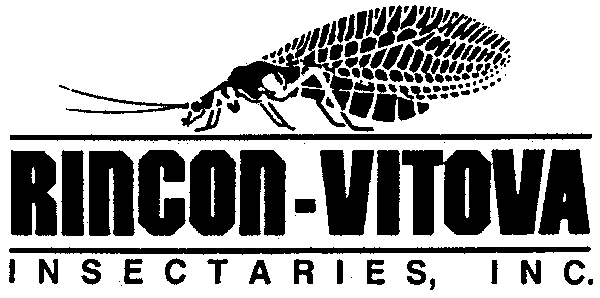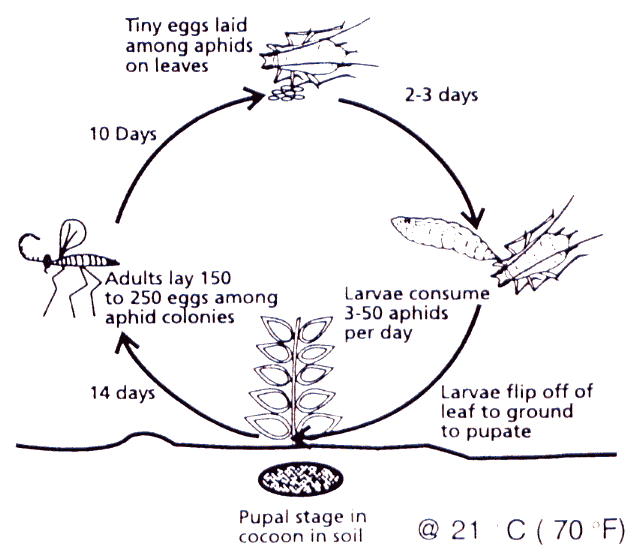|
|
|
|

|
Aphidoletes aphidimyza
Aphid Predatory Midge
by Applied BioNomics
PO Box 1555, Ventura, CA 93002
* 805-643-5407 *
- fax 805-643-6267
question e-mail bugnet@rinconvitova.com
orders orderdesk@rinconvitova.com
www.rinconvitova.com |

|
|
|
|
Target pest
Aphids, all types, to some extent potato (tomato, pepper) psyllid
Description
‘Aphidoletes’ larvae are voracious native predators of over 60 species of aphids.
- Larvae are orange, legless maggots, up to 3 mm (1/16 inch) long.
- Adults are small, delicate midges (flies) 2-3 mm (1/16 inch) long, with long legs. Adults are rarely seen as they are mostly active in the evening.
- Rincon-Vitova’s Aphidoletes are collected and shipped with no refrigeration to assure reliable emergence of adults with the ability to fly long distances to find aphids. You only need one midge per ten ft2 (m2) or 1200 per acre per week. Higher aphid populations are brought down with releases of 2400/acre to reach a ratio of one midge to 100 aphids. Refrigerating Aphidoletes translates into delayed, asynchronous emergence and a many-fold increase in the number needed. Our short-term holding and transit temperatures are between 55 and 65º F.
Use in Biological Control
- Aphidoletes are used to control aphids indoors in commercial greenhouses and interior plantscapes as well as outdoors in orchards, shade trees, roses and home gardens.
- Optimum conditions are 21-25º C (70-77º F) and high relative humidity (over 70%), particularly for the pupal stage, which must not dry out.
- If aphids are present in outdoor plants in late summer, a release of Aphidoletes at this time helps reduce the overwintering aphid population, while establishing an overwintering predator population that will be active early the following spring.
- A feature of Aphidoletes in production greenhouses is its habit of flicking the aphid off the foliage or flowers leaving no sign on the plant.
Monitoring Tips
Using 10-15 X hand lens, full grown larvae are easy to see among the aphids because of their characteristic orange color. Younger larvae are smaller and pale in color, difficult to see.

Life Cycle
Life cycle takes 21 days at 21º C (70º F) depending on temperature and prey availability.
- Sex ratio in populations vary, but there are usually somewhat more females (60% females).
- Female midges lay eggs on leaves beside aphids. Each female lays 150-200 eggs during her 1-2 week lifespan. The eggs are shiny orange ovals, less than 0.3 mm (1/50 inch) long.
- At 21ºC, eggs hatch in 2-3 days and tiny, legless larvae crawl on the leaf in search of aphids.
- Larvae feed by biting aphids and paralyzing them with a toxin before sucking out the aphid body fluids. They feed for 7-10 days and can kill 3-50 aphids per day. Where aphid populations are high, larvae kill many more aphids than they can consume.
- To pupate, larvae drop to the ground and burrow into the top 1-2 cm (1/2 inch) of soil or organic material to spin a cocoon. Adults emerge in 2-3 weeks.
- Outdoors, the last generation of Aphidoletes in the fall overwinters in the cocoons in the soil. They are very hardy and survive outside throughout the growing regions of Canada.
Product Information
Aphidoletes is sent as pupae (cocoons) in moist vermiculite or sand. The predators may be released in either of two ways:
- Immediately upon receipt, gently sprinkle the vermiculite carrying the cocoons onto the surface of the soil or growth media, in the shade; keep the vermiculite moist (not wet) until adults have emerged.
- Hold containers at 22ºC (70ºF) temperature checking daily for emergence until adults are seen flying in the container, then place the container with the corner cut open in the shade, greenhouse or garden, ideally at dusk.
- Adults should begin to emerge within 2-5 days and all should emerge within 10 days of receipt.
Note: Aphidoletes larvae respond to cool temperatures and shortening day lengths (less than 16 hrs) by entering diapause (like a hibernation state). There has been hesitation in the past to use them between September and mid-March. However new observations suggest a great value from low year-round releases in greenhouses to keep the pressure on low levels of aphids (see below).
Introduction Rates
Generally, Aphidoletes should be released in the spring, 2 or 3 times at 7-10 day intervals to establish the predator. With our fresh Aphidoletes you only need one midge per ten ft2 (m2) or 1200 per acre per week. Higher aphid populations are brought down with releases of 2400/acre to reach a ratio of one midge to 100 aphids.
Greenhouse Vegetables
Tomato – 1 Aphidoletes/6 plants, weekly for 2 weeks
Pepper – 1 Aphidoletes/plant, weekly or until established
Cucumber – 10 Aphidoletes/plant, weekly in infested areas only until established
Outdoor Use
Gardens – 250 Aphidoletes/aphid hot spot, weekly for 2 weeks
Orchards – 5-10 Aphidoletes/tree, weekly for 3 weeks
Shade trees/5-10 Aphidoletes/tree, weekly for 3 weeks
Roses – 3-5 Aphidoletes/plant, weekly for 3 weeks
For large areas, such as apple orchards, use 2,000-8,000 Aphidoletes/ha (1,000-4,000/acre), repeated 1-3 times, 1-2 weeks apart, or until established. For outdoor use, release in the evening upwind from the planting so prevailing winds help disperse the midges throughout the plot.
For Best Results
- Because they diapause at less than 16 hours daylength, Aphidoletes will not have long-term effectiveness in greenhouses during fall and winter unless there is heat or supplemental lighting. Leaving on one 60-watt light bulb all night will prevent diapause in more than half of the larvae within a 20 m (20 yd) diameter circle as long as night temperatures are above 15º C (60º F). Short days affect the larva when it goes into its pupa stage. If you are using Aphidoletes to clean up a few aphids, reproduction is not the goal. Also the low light diapause will be overridden by temperatures of 78° F (24° C) or higher. We encourage greenhouse operators to use Aphidoletes to suppress aphids year round. Our Aphidoletes can definitely be used in warmer greenhouses even with short day length and low light.
- The larvae need to burrow into damp soil, peat moss, sawdust or other growth media to pupate. In greenhouses with bare plastic or concrete floors, survival will be low unless such organic materials are provided. Adding sand, sawdust or other organic materials under the leaf zones of plants will improve reproduction of Aphidoletes.
- For control of cotton/melon aphid, which reproduces very quickly, and for high levels of aphids, Aphidoletes should be used along with Aphidius parasitic wasps and predators such as green lacewing and ladybugs.
- It may be necessary to control ants in conservatories and around outdoor trees because they can protect aphid colonies by removing predators. Prevent ants from entering tray.
- Best to allow Aphidoletes to emerge in container before release.
- Release by cutting the corner off the tray. This maintains the moisture in the container.
- Release at the end of the day.
- Turn off circulation fans the night after release so the adults won’t be chopped up and they can easily swoop down on their targets. After the first night they will settle in the canopy and not be affected by air flow of fans.
- "Critical" Release away from known Aphid "hot spots". This will force them to hunt and seek the new infestations and prevent them from crowding onto the easiest site.
- "Hot Spots" of Aphids should be handled by releasing extra Aphidoletes directly at the site, after a water or water/soap rinse. Rate is 10 per meter squared.
- Start program with clean crop, as soon as plant material is present, or at least before the historical arrival of Aphids.
- Weekly releases until crop is finished.
- Release rates are; 500 per acre or 1000 per hectare per week for low crops, such as flowers, perennials, lettuce, herbs, etc., 1500 per acre or 3000 per hectare per week for high, or dense crops, such as sweet pepper, cucumber, etc., 1000 per acre or 2000 per hectare per week for crops in between, such as, cut roses, gerbera, etc.
Using Pesticides
Ask for information on effects of specific pesticides on Aphidoletes. For example, pirimicarb (i.e., Pirliss®) is slightly toxic to Aphidoletes. It’s repellent effect disperses aphids. Pirimicarb residues have been found to repel Aphidoletes females from laying eggs on leaves; therefore, avoid frequent use. For organic, a Beauveria or essential oil product may be enough for hotspots along with insecticidal soaps. Soap is harmful to all stages of Aphidoletes, but has no residual effect.
© 2006 Rincon-Vitova Insectaries, Inc. Reproduction whole or part requires permission.


